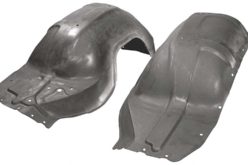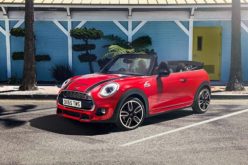
So, naturally, when I picked up my Chevrolet Corvette Stingray loaner – all swooping mid-engined angles and sparkling Accelerate Yellow Metallic paint – it was this hat I was wearing. Why? Well, because, like the two divergent examples of popular American culture on the hat — the Old Mother Road, baked into the earth below and the world of the famous space opera, many millions of miles above — the latest Corvette is an incredibly tantalizing mix of the old and the new and a nice window into where cars are at today.
The new, well, that’s pretty obvious. For the first time ever, the Corvette has swapped its traditional long-hooded, front-engine sports car digs for a mid-engined supercar body. It now has a perfect 50/50 weight distribution as a result, and cuts a profile unlike pretty much any American car this side of the Ford GT. It is an absolute head-turner; some people can’t believe it’s a Corvette, others nod with approval and recognition and still others are somewhat put-off by it. After all, when you’re a fan of a car that has pretty much become an institution, you’re not gonna necessarily love the idea of having your engine in the “wrong” place.
But why not? After all, the ‘Vette still gets a naturally-aspirated pushrod V8 good for 495 horsepower and 470 pound-feet of torque (that’s thanks to the performance exhaust that comes with my car’s 3LT Z07 package; take five off of each figure with standard exhaust), fed to the rear tires, and the rear tires alone. That means instantaneous response from the throttle, accompanied by a bloody great noise that only a V8 with quad outlet exhaust could produce.
It’s a strange dichotomy, actually, as the looks are modern to the point where the sound of an old school V8 seems at-odds with the environs. It seems like a car more likely to be powered by a twin-turbo V6 – yes, like that pesky Ford GT – so when you hear that V8 bellow, it really does make you stop and once again think about how different this new Corvette is.
Not to mention that the cockpit is ultramodern, with the digital gauge cluster and central display angled nicely towards the driver and providing a very cockpit-like feel. There’s also a heads-up display, because why shouldn’t there be? The Corvette has had one for over a decade now.
It feels a whole heck of a lot faster than 500 hp, too, especially if you drop the top on this convertible model. A quick aside on that: yes; all Corvettes can have the top removed, but the “coupe” models become more of a targa when the roof is off, a process that is done manually. The convertible gets a power folding top that leaves occupants much more exposed to the elements. That’s great, but it’s a shame you can’t see that bloody great big V8 as there’s an unmovable firewall between the roof stow area and the engine bay.

It’s great that you still get plenty of storage when you drop the top – there’s no less in that circumstance than there would be if you left the top in place, which is nice – but the bigger takeaway for those concerned with the performance of a vehicle is how bereft the drive experience is of the creaks and rattles we’ve come to expect from convertibles. It’s not just that those are annoying, but their presence often means you don’t have quite as much chassis fidelity as you’d get from the coupe, which means a hit to performance.
Not here, though. The drop top feels just as rigid and athletic as the coupe, which means what you have is a car that can make a reasonably skilled driver feel like a true driving star.
The front end responds so well to steering inputs, and body roll is so minimal that it’s almost imperceptible and the rear end follows the front through turns in a wonderfully predictable and tractable way. This is not a small vehicle, but it drives a whole lot smaller than it looks and since you sit so low and so over the front axle (there’s no big, long engine there, remember) you really feel like you’re part of the Corvette’s footprint as you scythe your way down your favourite mountain road together. At the same time, while you know there’s lots of car behind you – they had to fit that engine somewhere, right? – you don’t feel it and I found myself often surprised when looking in the wing mirrors and seeing all that real estate aft of my position.
The one transmission choice is a paddle-operated eight-speed dual-clutch auto, which manual purists will argue that quick as it is, it’s nowhere near as immersive. Perhaps not, but it is incredibly fast-shifting, each gear a joy to bang home. Then you start to saw the strange function-over-form steering wheel (shaped to not impede your vision or bump your thighs) and everything about this Corvette comes into focus.
You do have to put up with some strangeness, though; like the coupe, the centre stack, well, there isn’t really a centre stack but a thin strip of buttons – there are 14 of ‘em, and three toggles – for your climate controls. It takes some getting used to and errant elbows can strike the buttons when driving. You get used to it, but it takes awhile and the stand on which they sit kind of forms a barrier between driver and passenger.

Not much else to complain about here, though. The latest Corvette is a massive departure from previous models and it’s reached a level of dynamism never before seen from the model; not even from the hotted-up Z06 and ZR1 versions. That’s saying something and while the looks aren’t for everyone, the drive absolutely should be and that’s what counts at this level.








































